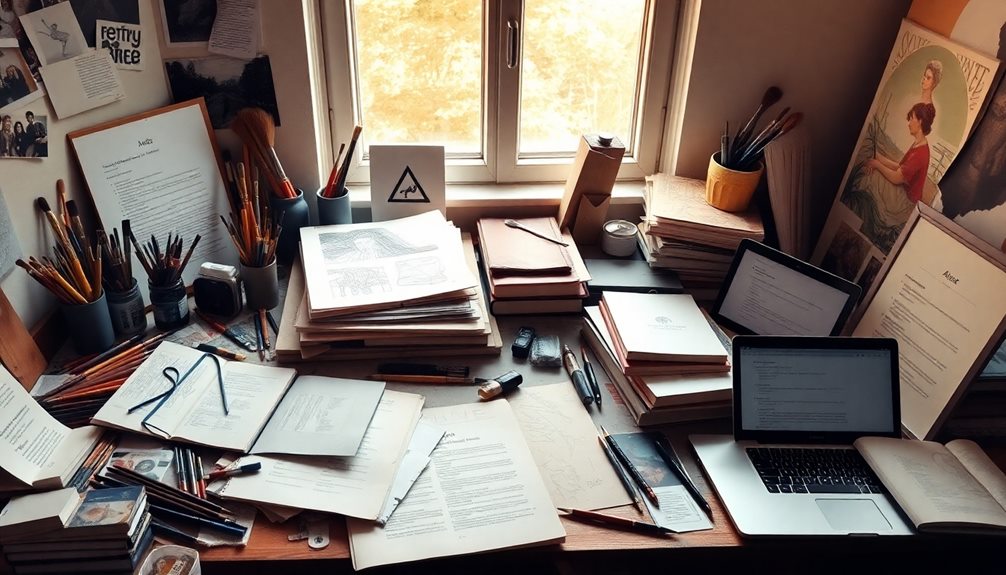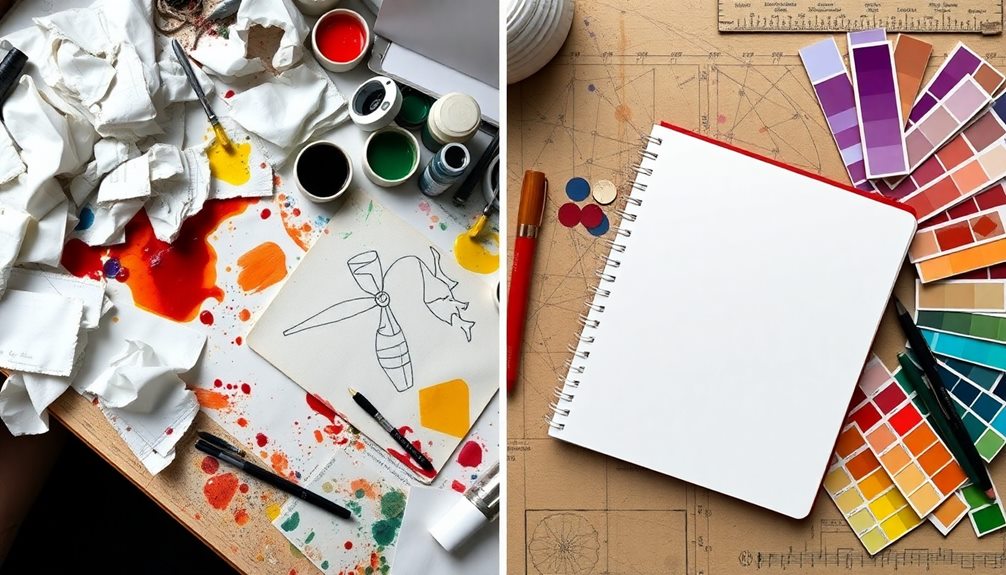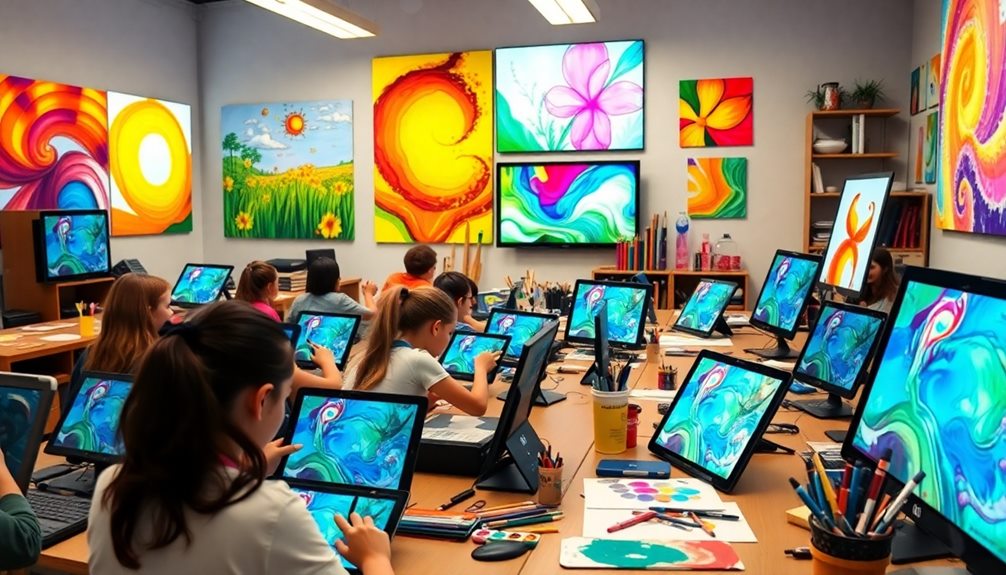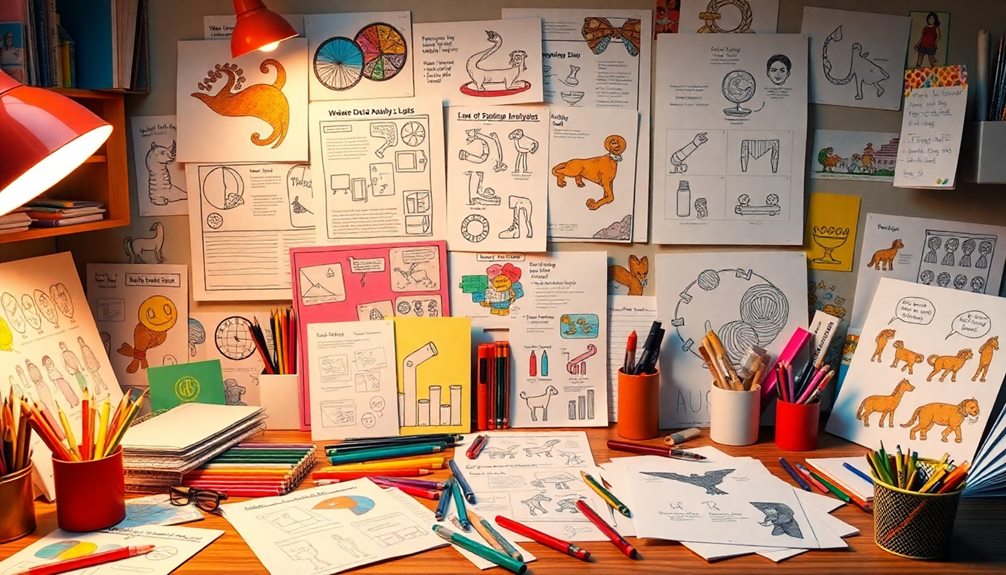In art writing, you might stumble into mistakes like unclear arguments and overemphasis on personal voice, which can weaken your piece. It's crucial to anchor your views with evidence and historical context. Forgetting to revise your work can lead to fragmented narratives that lack flow. Consistent formatting is key to maintaining professionalism, so pay attention to citation styles and italicize artwork titles. Avoid clichés and redundant phrases to keep your voice fresh and engaging. By focusing on these areas, you can enhance your writing. There's plenty more to consider that can deepen your understanding and elevate your craft.
Key Takeaways
- Overemphasizing personal voice can overshadow critical analysis; balance subjective insights with objective commentary for credibility.
- Supporting personal views with evidence is essential; lack of evidence undermines the strength of your arguments.
- Failing to consider established art historical contexts weakens your analysis; always integrate relevant contexts to enrich your writing.
- Inconsistent citation formats can detract from professionalism; adhere to a single style guide, such as the Chicago Manual of Style.
- Neglecting the revision process leads to fragmented narratives; prioritize multiple revisions to enhance clarity and coherence in your writing.
Introduction
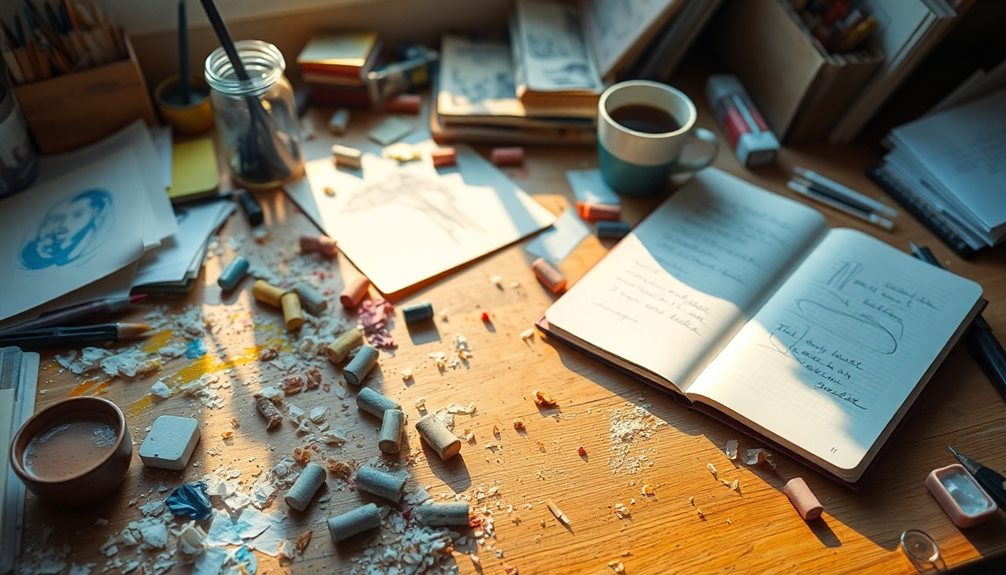
When you embark on art writing, it's essential to begin with a clear and engaging introduction that sets the tone for your analysis. A strong introduction not only captures your reader's attention but also lays the foundation for a coherent argument.
To achieve this, you need a strong structure that outlines your main points and guides your audience through your insights. Incorporating contextual research is crucial as it enriches your analysis by providing historical and cultural backgrounds that inform your interpretations.
Additionally, understanding how AI in business can enhance communication could also benefit your writing by improving clarity. Avoid vague language and clichés, as they can dilute the impact of your writing and make your arguments less convincing.
Misusing terminology or failing to italicize artwork titles can undermine the professionalism of your work, so pay attention to these details.
Key Concepts and Definitions

Understanding key concepts and definitions is crucial in art writing, as they form the backbone of your analysis. For art students, clarity and precision are paramount. When discussing artworks, avoid common pitfalls like vague language and meaningless adjectives. Instead, focus on articulating your thoughts with clear definitions and specific terms that enhance reader understanding. Incorporating high-quality content can also boost your credibility and make your analysis more engaging.
Proper formatting is another essential aspect. Always italicize the official titles of artworks and place sections within larger works in quotation marks. This attention to detail reflects professionalism and aids in comprehension.
When describing emotions evoked by art, ground your observations in visual elements and contextual support rather than relying solely on personal impressions. This approach maintains objectivity and bolsters your arguments.
Additionally, steer clear of clichés and redundant phrases; they dilute originality and fail to engage your readers.
Lastly, never underestimate the importance of contextual research. Providing historical and cultural backgrounds enriches your analysis, offering depth that informs your interpretations. By mastering these key concepts and definitions, you'll elevate your art writing and connect more effectively with your audience.
Essential Writing Techniques
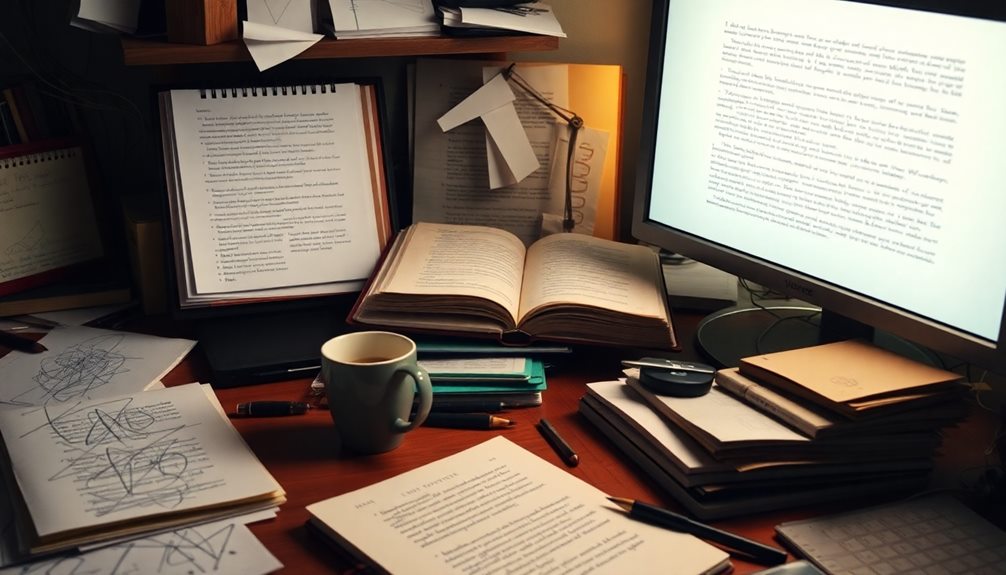
Mastering writing techniques is vital for improving your art analysis. To begin, focus on using precise terminology. Avoid vague language that can confuse your readers; clarity strengthens your arguments. When discussing an artwork, ensure you articulate your thoughts with exact words that convey your meaning effectively.
Additionally, maintaining a positive mindset can enhance your creativity and openness while writing, allowing for a more engaging analysis of the artwork's nuances. Embracing continuous learning and adaptation fosters a deeper understanding of various artistic styles.
Incorporate contextual research into your writing. This adds depth to your analysis and enriches your understanding of the artwork's significance. Knowing the historical, social, or cultural context can provide valuable insights that enhance your discussion.
Structure your essays with clear introductions, coherent arguments, and strong conclusions. This logical flow of ideas helps your readers follow your reasoning and reinforces your points. Each paragraph should connect seamlessly to the next, maintaining clarity throughout.
Don't forget to edit and revise your work multiple times. This process improves clarity and coherence while enhancing overall quality. Seek feedback from peers to gain diverse perspectives, which can help you identify areas for improvement.
Lastly, steer clear of clichés and overused adjectives. Originality in your writing not only engages readers but also reflects your critical thinking in art analysis. Embrace these essential techniques to elevate your art writing.
Art Critique Breakdowns

Art critiques play a crucial role in deepening your appreciation of artwork, as they combine descriptive language with analytical insights. A well-crafted critique doesn't just summarize; it delves into the artwork's formal qualities and conceptual underpinnings. To achieve this, you need to avoid vague language and overused adjectives. Instead, opt for precise terminology that clearly communicates the artist's intentions and the work's impact.
A clear structure is essential in your art writing. Start with an engaging introduction to the artwork, then move into a detailed analysis that logically flows into your concluding summary of insights. This coherent organization helps your audience grasp your perspective.
Incorporating contextual research is another vital aspect. By situating the artwork within its historical, cultural, and artistic frameworks, you enrich your critique and provide deeper understanding.
Don't forget to engage with audience feedback; it can enhance your critiques by revealing viewer interpretations that may guide your future analyses. Striving for clarity and precision in your critiques not only elevates your writing but also fosters a more nuanced perspective on the art you're discussing.
Tips and Best Practices

Critiquing artwork effectively goes hand in hand with knowing the best practices for art writing. Make sure you use precise terminology and avoid vague language to enhance clarity and strengthen your arguments. This specificity helps your descriptions hold meaning and allows readers to connect with your analysis.
Structure your essays with clear introductions, logical flow, and strong conclusions. This organization not only aids comprehension but also reinforces your central thesis. To add depth to your observations, incorporate credible research and contextual understanding. This enriches your analysis and showcases your strengths as a writer.
Editing and revising your work multiple times is crucial. This process improves clarity and coherence, so don't hesitate to seek peer feedback, as it offers valuable perspectives on your writing.
Additionally, avoid clichés and overused adjectives; originality in your language engages readers and reflects critical thinking.
Audience Feedback on Critiques

Audience feedback can be a game-changer for artists looking to refine their work and connect with their viewers. Engaging with audience feedback provides valuable insights that help you improve your skills, as constructive criticism often highlights areas for growth. It's not just about receiving praise; it's about understanding what resonates and what doesn't.
When students make the effort to actively seek feedback, they foster a sense of community and loyalty among their viewers. This encourages people to invest more in your artistic journey. By incorporating audience perspectives, you can guide the direction of your new projects, aligning your artistic choices with market preferences and enhancing relevance.
Listening to constructive criticism can lead to innovative artistic evolution, allowing you to refine your techniques and expand your creative boundaries. Regularly soliciting feedback promotes open communication with your audience, building a stronger connection that enhances the impact of your work.
Don't shy away from audience input; instead, embrace it as a vital tool for growth. Remember, the more you engage with your audience, the better equipped you'll be to create work that truly resonates.
Balancing Personal and Academic Voice

Finding the right balance between personal and academic voice can elevate your art writing, making it both authentic and engaging. While personal insights can add depth and uniqueness to your narrative, they should complement your critical analysis rather than overshadow it. Use anecdotes sparingly; they can illustrate a point but should always be paired with scholarly commentary to maintain an objective tone.
Incorporating precise language is essential. Avoid vague descriptors that can cloud your interpretation. When you express personal views, back them up with evidence from the artwork to ensure clarity and credibility. This combination of personal reflection and academic writing creates a richer understanding of the piece.
Additionally, grounding your insights within established art historical frameworks enhances your argument's scholarly rigor. This not only strengthens your voice but also resonates with a wider audience.
Make it a habit to revise your drafts, integrating both personal and academic elements seamlessly. This careful revision process will help you create a cohesive narrative that invites readers to engage with your perspectives while appreciating the analytical depth of your work.
Balancing these voices can truly transform your art writing experience.
Additional Resources

As you dive deeper into art writing, exploring additional resources can significantly enhance your skills and understanding. Start by utilizing academic databases and libraries to access scholarly articles and books. These resources provide in-depth analysis and context, helping you grasp complex themes in art criticism.
Consider engaging in workshops or online courses focused on art writing. These structured environments allow you to refine your skills while receiving valuable feedback from instructors and peers. You'll gain insights into effective techniques that can elevate your writing.
Joining art writing communities or forums can also be incredibly beneficial. These platforms offer opportunities to share resources, critique each other's work, and discuss best practices with fellow writers. You'll find a supportive network that can inspire you and keep you motivated.
Don't forget to consult style guides specific to art writing, like the Chicago Manual of Style. Proper citation formats and terminology usage are crucial in maintaining professionalism.
Frequently Asked Questions
How to Avoid Common Mistakes in Writing?
To avoid common mistakes in writing, focus on clarity and structure. Edit your work thoroughly, seek feedback, and support your arguments with credible sources. Embrace originality to engage readers and enhance your critical thinking.
What Are Mistakes in Art?
When creating art, you might overlook proportion, use clashing colors, or neglect composition. These mistakes can affect your work's overall impact. Embrace experimentation, and don't hesitate to seek feedback to improve your skills.
What to Avoid in an Art Portfolio?
In your art portfolio, avoid submitting too many pieces that lack quality. Don't forget to showcase diverse skills, ensure high-resolution images, seek feedback, and create a cohesive narrative that highlights your unique artistic voice.
How Do You Fix Art Mistakes?
To fix art mistakes, identify the error and assess if it can be corrected with techniques like layering or glazing. Use a color wheel for mixing, and refer to foundational principles for accurate adjustments.
Conclusion
In conclusion, by avoiding common mistakes in art writing, you can enhance your critiques and connect more effectively with your audience. Remember to balance your personal voice with academic rigor, and stay open to feedback. Use the techniques and tips we've discussed to refine your approach, ensuring your writing is both insightful and engaging. Keep practicing, and you'll find your unique style while making meaningful contributions to the art conversation. Happy writing!



